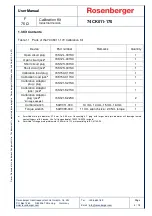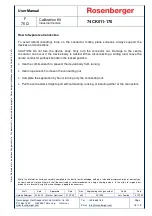
User Manual
F
75
Ω
Calibration Kit
Industrial Version
74CK011-170
Rosenberger Hochfrequenztechnik GmbH & Co. KG
P.O.Box 1260 D-84526 Tittmoning Germany
www.rosenberger.com
Tel. : +49 8684 18-0
Email : [email protected]
Page
14 / 15
D
ie
s
e
s
D
o
k
u
m
e
n
t
is
t
u
rh
e
b
e
rr
e
c
h
tl
ic
h
g
e
s
c
h
ü
tz
t
●
T
h
is
d
o
c
u
m
e
n
t
is
p
ro
te
c
te
d
b
y
c
o
p
y
ri
g
h
t
●
R
o
s
e
n
b
e
rg
e
r
H
o
c
h
fr
e
q
u
e
n
z
te
c
h
n
ik
G
m
b
H
&
C
o
.
K
G
6.3 Handling and Storage
•
Install the protective end caps and store the calibration devices in the foam-lined storage case
when not in use.
•
Never store connectors loose in a box, or in a desk or bench drawer. This is the most common
cause of connector damage during storage.
•
Keep connectors clean.
•
Do not touch mating plane surfaces. Natural skin oils and microscopic particles of dirt are easily
transferred to a connector interface and are very difficult to remove.
7. Connections
Good connections require a skilled operator. The most common cause of measurement error is
bad connections. The following procedures illustrate how to make good connections.
Making a Connection
The calibration kit comes with a so-called combi-wrench which is a useful tool to make
connections. This wrench helps you to hold the device body and prevent it from rotating while
making a connection.
Preliminary Connection
1. Ground yourself and all devices. Always wear a grounded wrist strap and work on a
grounded, conductive table mat.
2. Visually inspect the connectors.
3. If necessary, clean the connectors. Refer to 4.1 Connector Care.
4. Check connector gage according to 6.2.1 and 6.2.2.
5. Carefully align the connectors. The male connector centre pin must slip concentrically into
the contact finger of the female connector.
6. Push the connectors straight together and tighten the connector nut finger tight.
CAUTION: Do not turn the device body. Only turn the connector nut. Damage to the centre
conductor can occur if the device body is twisted.
Do not twist or screw the connectors together. As the centre conductors mate, there is
usually a slight resistance.
7. The preliminary connection is tight enough when the mating plane surfaces make uniform,
light contact. Do not overtighten this connection. A connection in which the outer
conductors make gentle contact at all points on both mating surfaces is sufficient. Very
light finger pressure is enough to accomplish this.
8. Make sure the connectors are properly supported. Relieve any side pressure on the
connection from long or heavy devices or cables.
9. Use the combi wrench and the torque wrench included in this calibration kit to make the
final connection. Hold the female connector with the combi wrench and position the torque
wrench at right angle to the axis of the connection and in the indicated working direction.
Hold the handle in the middle and turn it until the torque wrench “breaks”.

































